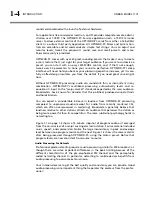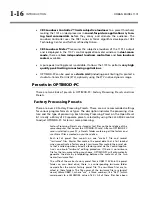
1-12
INTRODUCTION
ORBAN MODEL 1101
and 75
μ
s. This allows it to protect preemphasized
satellite uplinks and similar
channels
where protection limiting or light processing is required. It can also be
used to process analog television FM aural carriers in television applications be-
cause these are usually processed lightly compared to FM radio.
Because its processing topology is most effective with “flat media,”
OPTIMOD-PC cannot provide extreme loudness for preemphasized radio
channels. Use one of Orban’s Optimod-FM processors for this application.
For analog television with FM aural carrier(s), use Optimod-TV 8382.
•
Two-Band
automatic gain control
with window gating and selectable L/R or
sum/difference processing compensates for widely varying input levels.
•
Shelving
bass equalizer
and three-band
parametric
equalizer
let you color
the audio to your exact requirements.
•
Low-IM look-ahead limiter
effectively limits peaks while ensuring that low-
bit-rate codecs operate optimally without overload.
•
Starting with V3.2 software, Optimod-PC implements
“true peak” control
by
oversampling the peak limiter’s sidechain at 192 kHz. This allows Optimod-PC
to
prevent clipping in a playback device’s analog signal path
by predicting
and controlling the analog peak level following the playback device’s recon-
struction filter to an accuracy of better than 0.5 dB. For typical program mate-
rial, accuracy is 0.2 dB
Without true peak control, analog clipping can occur even if all peak values of
the digital samples are below 0 dBFS. This phenomenon has also been termed
“
0 dBFS+
.”
Thanks to true peak control,
sample rate conversion
, unless it removes high
frequency program energy or introduces group delay distortion,
cannot cause
sample peaks to increase more than 0.5 dB
. For example, sample rate con-
version from 48 kHz to 44.1 kHz is highly unlikely to cause sample peak clipping
in the 44.1 kHz audio data.
•
OPTIMOD-PC’s
dual-mono
architecture allows entirely separate mono programs
to be processed in 5-band mode, facilitating dual-language operation.
In this mode, both processing channels operate using the same process-
ing parameters (like release time); you cannot adjust the two channels to
provide different processing textures.
•
Two AES3 or S/PDIF digital inputs
with high-quality sample rate conversion
allow two asynchronous digital sources to be mixed: Ideal for network opera-
tions using local commercial/announcement insertion.
•
The
second digital input
also accepts AES3 house sync, synchronizing the AES3
output sample rate to the sample rate of the sync input.
Summary of Contents for Optimod-PC 1101
Page 4: ......
Page 14: ......
Page 121: ...OPTIMOD PC OPERATION 3 1 Section 3 Operation Figure 3 1 The OPTIMOD PC Control Application...
Page 192: ...3 72 OPERATION ORBAN MODEL 1101...
Page 204: ......
Page 210: ......
Page 212: ...5 2 UNINSTALLATION ORBAN MODEL 1101...
Page 236: ......















































